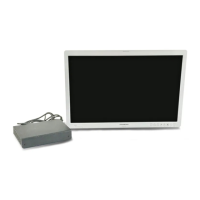
Do you have a question about the Olympus OEV261H and is the answer not in the manual?
| Contrast Ratio | 1000:1 |
|---|---|
| Response Time | 8 ms |
| Display Size | 26 inch |
| Viewing Angle | 178° (H) / 178° (V) |
| Input Ports | DVI-D |
Specifies the intended applications and limitations of the monitor.
Guidance on how to effectively and safely use the instruction manual.
Information on ensuring compatibility with ancillary medical equipment for safe operation.
Warnings against unauthorized disassembly or repair of the instrument.
Explanation of the signal words (DANGER, WARNING, CAUTION, NOTE) used in the manual.
Critical safety precautions to prevent electric shock, fire, and injury.
Provides a brief overview of the monitor's features and design.
Describes the front and rear views of the video monitor unit.
Details the buttons, switches, and indicators on the monitor's front panel.
Identifies and explains the various input/output terminals on the rear panel.
Explains the AC adapter's connections, indicators, and power switch.
Provides instructions and safety precautions for mounting and positioning the monitor.
Guides on proper placement and installation of the AC adapter.
Step-by-step instructions for connecting the monitor to an AC power source safely.
Procedures for verifying power supply and quality of the displayed image.
How to load and save input and image quality settings using the PRESET button.
Describes selecting input signals for PORT A and PORT B using the INPUT button.
Details how to navigate and adjust settings through the monitor's menu system.
Explains how to switch between various Picture-in-Picture (PIP) display modes.
Describes how to switch between various Picture-out-Picture (POP) display modes.
How to magnify single screen and PIP large screen displays using the SCAN button.
How to assign and trigger functions using the F1 and F2/ENTER buttons.
Explains the information presented on the status display screen.
Configuring the monitor's input signal selections and formats.
Adjusting settings for computer (COMP) input, including autosetup.
Adjusting video signal parameters like backlight and color temperature.
How to fine-tune white balance for optimal color reproduction.
Setting image quality parameters for specific video input terminals.
Configuring system-wide settings like menu position and power management.
Assigning functions to buttons and setting language and startup logo.
Configuring Picture-in-Picture (PIP) and Picture-out-Picture (POP) display modes.
Setting up remote control operations via GPI input terminals.
Managing control lock and front panel operation locks.
Details GPI terminal functions and their operating conditions for remote control.
Instructions on how to safely clean and maintain the monitor's exterior and screen.
Recommendations for storing the monitor and proper disposal procedures.
Explains the necessity of regular inspections for sustained performance and safety.
A table of common issues, their causes, and recommended solutions.
Instructions on how to contact Olympus for product repair services.
Lists recommended equipment combinations for use with the OEV261H monitor.
Illustrates the typical system configuration involving EVIS video equipment.
Shows the system setup when using camera control units with the monitor.
Details compatible video and monitor cables for various Olympus video system centers.
Lists compatible remote cables and LCD monitor mounts for mobile workstations.
Details compatible video cables for OTV-S7Pro and related video system centers.
Provides environmental conditions and operational specifications for the monitor and AC adapter.
Lists the technical specifications of the LCD display panel, such as size and resolution.
Details the types and quantities of input and output terminals on the monitor.
Lists the specifications for video signal outputs and DC power supply output.
Information regarding electromagnetic compatibility standards and emissions compliance.
Details the monitor's immunity to electromagnetic interference and recommended environments.
Advises on safe usage around portable and mobile RF devices like cellular phones.
Provides guidance on safe separation distances from RF emitting devices.